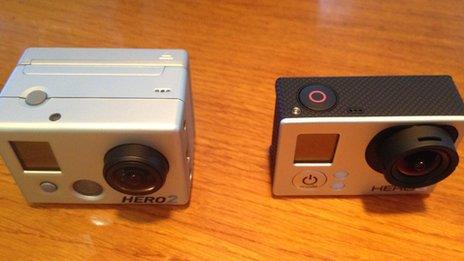Gadgets get connected
- Published
- comments
Competition between the world's electronics manufacturers seems to be getting ever more intense - which is good news for gadget lovers.
From phones to cameras to set-top boxes, every device seems to get smarter every few months, thanks no doubt to Moore's Law. And now it seems any new product has got to have something else - an internet connection. I've been looking at two new gadgets whose appeal could be transformed by the addition of connectivity.
Livescribe pen

The Livescribe digital pen, which records audio and matches it to the notes you make with it on special paper, has been around for three years or so. It has a James Bond appeal - though it doesn't explode - and when I've used one it has always attracted interest.
The company behind it has the backing of some smart Silicon Valley investors, but I've been somewhat dubious about its long-term prospects. Isn't the pen a dying technology when most of us are now more comfortable typing - and isn't the process of transferring your notes from the pen to a computer just too cumbersome? Two years ago I wrote this about the Livescribe:
"There's just a little too much friction in the process - if you could wirelessly beam the notes and audio from the pen direct to the cloud, rather than having to plug it into a computer, then it might be a compelling product."
Well they must have been listening because the new version of the Livescribe does just that. It has a wi-fi connection, and is integrated with the Evernote cloud storage application, so that any notes or recordings you make are synced to your online account the minute the pen is online (see image above).
Now this is pretty compelling - any note you write stored online to be retrieved whenever you want. Whether it is enough to give the digital pen its breakthrough moment - sales have been treading water for the last 18 months - is another matter.
But the Livescribe people say there is evidence that even people who are heavy users of computers and smartphones still find a pen the quickest way of taking notes. The only problem is that many of us - including me - now have such poor handwriting that any kind of pen, digital or not, is not the best way of communicating.
GoPro camera
Another gadget whose appeal could be transformed by connectivity is the GoPro camera. When I started in television more than a quarter of a century ago, a broadcast video camera kit cost something like £30,000 - and if you had suggested strapping one to a car to get action shots you would have been sacked.

Now there are plenty of tiny sports and action cameras available for under £300, all providing far higher quality footage than we used to get from those early video cameras. The leader of the pack is probably GoPro, a company started by some surfers in Half Moon Bay, California.
Look on YouTube for videos of any action sports - from rally driving to skiing to windsurfing - and you are likely to find material shot on a GoPro. They are also becoming commonplace in the television industry and many of the news camera crews I've worked with in recent months have used them alongside their professional kit.
Now the latest version of the camera is not only even smaller, it has built-in wi-fi enabling the user to operate it and monitor shots via a smartphone app. That is clever, but what is really interesting is the promise that a future update of the app could allow you to stream live to the internet from the camera.
That could put a high quality live broadcasting capability into the hands of all sorts of people, both amateur and professional, and could have big implications for the way live events or news are covered.
But GoPro is far from alone in this market - and the biggest name in video cameras Sony is now muscling in with its own tiny action camera. It too is wi-fi-enabled and can be controlled via a smartphone app, and it seems wireless connectivity is now becoming a feature of many cameras at all sorts of price levels.
A decade ago, wireless technology was just beginning to enter the home, with most of us still plugging cables into the wall to connect our computers to the internet. Now what has been called the internet of things is taking shape, with all sorts of products, from a fridge to a camera to a pen, having the ability to connect to the web. Just wait until they start talking to each other.